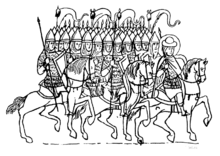Military of Kievan Rus'

The military of Kievan Rus' served as the armed forces of Kievan Rus' between the 9th to 13th century. It was mainly characterised by infantry armies of town militia that were supported by druzhyna cavalry.
Composition

Tribal militia known as
The regiments of city militia, raised by the decision of the veche,[4] were formed in the 11th century. These regiments received weapons and horses for a campaign from the prince.[citation needed]
Tactics and equipment

Before
At the same time, the main part of the Kievan Rus' army was the militia infantry. It was inferior to druzhyna in armament and the ability to own it. The militia used axes and hunting spears ("rogatina"). Swords were rarely used, and they had no armour other than plain clothes and fur hats.[5]
For the
Legacy
During the
See also
References
- OCLC 216653180.
- ^ Perrie 2006, p. 58.
- ^ Perrie 2006, p. 81.
- ^ Perrie 2006, p. 83.
- ^ )
- ^ Perrie 2006, p. 54.
- OCLC 1003145949.)
{{cite book}}: CS1 maint: multiple names: authors list (link - ^ "Никифоровская летопись. Никифорівський літопис. Том 35. Литовсько-білоруські літописи". litopys.org.ua. Retrieved 17 March 2018.
- ^ "Новгородская летопись". krotov.info. Retrieved 17 March 2018.
- OCLC 38550301.
- ^ Perrie 2006.
- ^ Perrie 2006, p. 218.
Bibliography
- Perrie, Maureen (2006). The Cambridge history of Russia. Cambridge University. ISBN 9780521812276.
